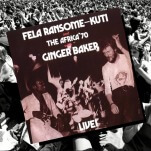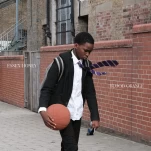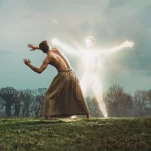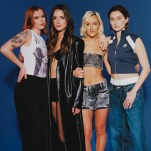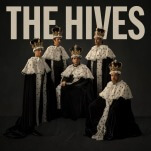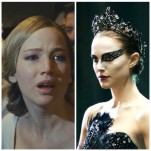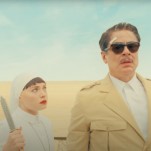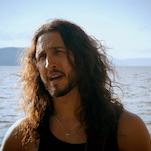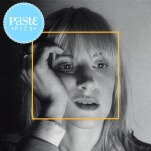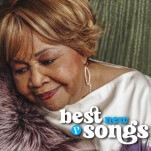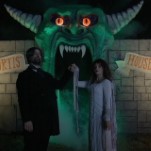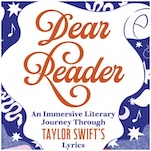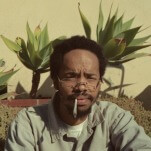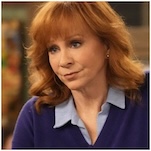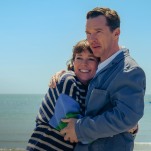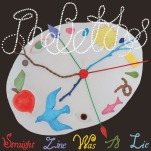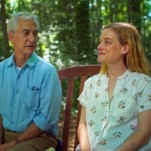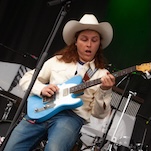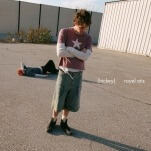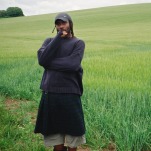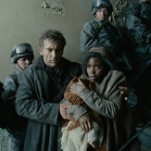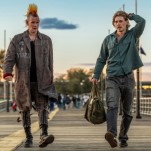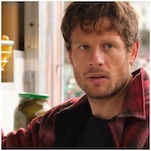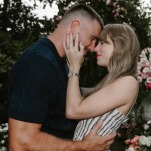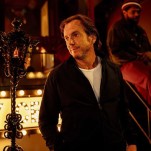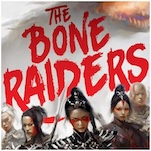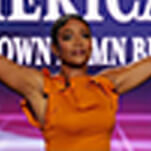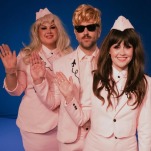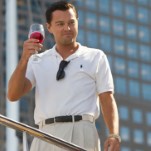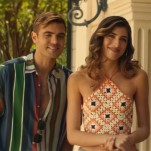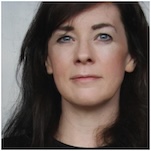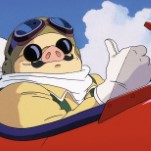But what if they hadn’t broken up? What if John Lennon, George Harrison and Ringo Starr had reacted to Paul McCartney’s resignation by hiring a new bassist? What if they had kept going with a new line-up for years of new Beatles albums and tours?
This is not what happened. This is what might have happened:
When he got the news that Paul McCartney had issued a press release that he was quitting The Beatles, Ringo Starr was not surprised but he was shocked. It was like knowing for a long time that a long-sick family member was going to die and still being staggered by the news that he had in fact died.
It wasn’t as if Paul were the first Beatle to threaten to quit the band. George Harrison had quit during the making of Let It Be, and Ringo himself had left the band for two weeks during the same sessions. John Lennon had told the others that he was leaving at the end of those sessions. But that had all been handled within the family, and the group had stayed together to make Abbey Road. But here was a public announcement, and it would be hard to put this genie back into the bottle. Moreover, Paul had been the one holding the quartet together for the past two years with his often annoying but usually effective cajoling and pep talks. If he had given up, what hope was there?
It was April, 1970, and it took Ringo half a dozen tries to get John, his best friend in the band, on the phone. “John,” the drummer said, “can we get together at a pub for a pint?”
John hemmed and hawed in a way that made it clear that his new girl friend Yoko Ono was in the room with him. “Well, I don’t know, Ringo,” he replied, “me and Yoko got a lot on our plate this week.”
“C’mon, mate, you owe me this much,” Ringo insisted, and John succumbed, mumbling the address of an undistinguished tavern not far from the Apple headquarters.
He was dismayed when John showed up, half an hour late, with Yoko in tow, but Ringo suppressed his irritation and vowed to himself to see it through. John was wearing a chocolate brown suit to go with his bushy beard, silver-rimmed round glasses and middle-parted brown hair; Yoko’s thick mane of black hair seemed to flow into her black sweater and black slacks. Ringo, his dark sideburns creeping toward his slanting mustache, drained half his pint before launching into his prepared speech.
“It’s fine for you, Paul and George,” he said. “You’re all songwriters and you can make solo albums. But I’m a drummer; if I’m going to make music, I need a band, and I’m never going to find a better band than this one. If Paul wants to quit the group, godspeed to him. Let’s hire Klaus and keep going.” The Beatles had known Berlin’s Klaus Voorman since their Hamburg days, and Klaus had not only designed the Revolver cover but had also played bass on Manfred Mann’s “The Mighty Quinn” and the Plastic Ono Band’s “Instant Karma.” “We won’t be the first band to replace the bass player, and we won’t be the last. It’ll be easier without Paul harping about playing this way or that way.”
Yoko didn’t say anything, but she stared meaningfully at John when he glanced in her direction. “I don’t know, Ringo,” he said. “Yoko and I have a bunch of projects we’re working on. I don’t have time to be a Beatle anymore. Besides I’m tired of being a Beatle. I want a chance to just be John for a while.”
Ringo had been anticipating this objection. “I’m not asking you to be a Beatle full-time; I’m just asking you to be a Beatle half of the time. You can work on your solo projects half the year—and your projects with Yoko, of course,” he quickly interjected. “George can work on his Indian and spiritual stuff.” He laughed and added, “And I, I can work on my tan.”
“I don’t know,” John said. “It feels like going backward.” The waiter brought another tray of tall pint glasses, and with typical British discretion pretended not to notice who his customers were.
“I know you wanna do the electronic music like Two Virgins and the political songs like ‘Give Peace a Chance,’” Ringo countered, “but I know there’s a part of you that still loves Elvis and Jerry Lee, the Coasters and the Drifters, that still wants to play rock’n’roll. The Beatles could be your rock’n’roll project alongside your other projects.” John, obviously unconvinced, stared off at the nearby dartboard.
Ringo was desperate. He could foresee a bleak future as an ex-Beatle: either playing recording sessions for bands that weren’t nearly as good as his former group or holed up in his suburban mansion watching TV and drinking too much. Now was the time to play his trump card. “If you let the Paul break up The Beatles,” he said, “you’re conceding the point that he’s so important that The Beatles can’t go on without him. You’re agreeing with him that the rest of us can’t be The Beatles if he’s not there.”
John’s head snapped around. This dart had found its bull’s eye. “Fuck Paul,” John snarled. “We don’t need him. We can be The Beatles without his little ditties.” He didn’t notice that Yoko’s shoulders slumped at this turnabout, and Ringo wasn’t about to call attention to her reaction.
“Look, we’ll hire Klaus and go into the studio in May to make a new album,” Ringo added quickly. “Then you can take the summer off to work on your own projects, and we’ll get back together in October to play some shows when the record comes out.”
John groaned. “Like Shea Stadium, you mean?” he said. “No way.”
“No,” Ringo said, “we’ll play big theaters with good sound systems. We’ll actually be able to hear ourselves this time. I thought you enjoyed playing in Toronto last year.”
“Yeah, I did,” John answered. “Look, we’ve got to go. Go ahead and contact George and Klaus, and if they’re on board, I’ll come to a meeting to talk about it at least.”
That was all Ringo needed to hear, and after John left, he called George from the red phone booth outside the pub, ignoring the pedestrians waving at him from the sidewalk. He was soon invited to George’s Friar Park country estate, and drove out there two days later. As Ringo drove through the gate of striped red-and-white stone toward the turret-topped castle, he was once again reminded of a British Disneyland. George’s hair was shaggier than ever, and he wore an Indian-print cotton shirt over blue jeans as he showed Ringo to an armchair in the parlor. George’s wife Patti brought out two cups and a pot of Darjeeling tea on a silver tray, set them on an antique table and slipped away.
“I talked to John on Tuesday,” Ringo said, “and he’s open to the idea of keeping The Beatles together with Klaus on bass if you are.”
“C’mon, Ringo,” George replied, “The Beatles are dead. Let them rest in peace. I’ve got all these songs saved up that John and Paul would never put on a Beatles album, and now I’m going to put them on a solo album.”
“But don’t you see?” Ringo continued. “With Paul gone, you’ll be able to get more of your songs on the album. And you’re not going to find a better rhythm section than me and Klaus.” George got up from his chair and paced the carpet for a while. Ringo held his breath.
“I don’t know,” George said at last. “Paul got on my nerves, but John has said some really nasty things about my songs. I don’t want to go through that again.”
“It’ll be different this time,” Ringo said; “I’ll stand up for you.” He had a sudden flash of inspiration. “In fact, I’ll decide which songs we record. I’m not a songwriter, so I’ll be an impartial judge.”
“But you never really shared my interest in meditation and Indian music,” said George doubtfully.
“Look, mate, that stuff was never my cup of tea, but I really love your stuff like ‘Something’ and ‘Here Comes the Sun.’ As I told John, The Beatles would only be a half-time band. The other half of the year, you could work on your own projects. You could record your rock’n’roll songs with The Beatles and your other songs with whomever you want. Even a half-time Beatles could pay for everything else you want to do.”
“I don’t care about the material world and all its encumbrances,” George said coolly.
“Well, a little cottage like this can’t be cheap to keep up.”
George stared at him icily for a moment, then broke into laughter. “Bless you, Ringo, you’re still the same bounder I knew in Liverpool. You’re the only one of us that’s halfway sane. Okay, I’ll get together with you, John and Klaus for a rehearsal, and we’ll see how it goes.”
The revamped Beatles line-up had their first rehearsal two weeks later in the Apple Studios on Tuesday, May 5, 1970, at 2 pm. At least Ringo and Klaus were there at 2 pm. George strolled half an hour later, and the trio warmed up on some old Everly Brothers, Buck Owens and Carl Perkins numbers. They were playing Perkins’ “Dixie Fried” when John sauntered in at 3:15. He didn’t offer any excuse; he just unpacked his guitar, plugged in and beefed up George’s hillbilly guitar and adding a low-tenor harmony. They continued without any discussion through other early-rock numbers that they all knew: The Robins’ “Framed,” The Drifters’ “Save the Last Dance for Me” and Elvis Presley’s “That’s Alright, Mama.”
But when Klaus suggested that they do a Chuck Berry song, John scowled and said, “No way. Chuck Berry’s suing me. Why don’t we try a new song I just wrote?” He showed them the chord changes to “Working Class Hero”; the three others picked it up quickly. They played it once with the static, march-like rhythm John had shown them, but the second time through George began to swing the rhythm a bit in the fashion of Merle Haggard; Ringo and Klaus followed his lead. Soon the song assumed a Beatlesque flavor that it never would have had on a John Lennon solo album.
Ringo had made a point of inviting neither George Martin nor Phil Spector, The Beatles’ only producers, to the sessions, but the band’s longtime engineer Geoff Emerick was at the board and he recorded “Working Class Hero” and George’s “Beware of Darkness,” which lost its lugubrious tempo as Ringo and Klaus sped it up. The new bassist wasn’t as melodic or as inventive as the man he replaced, but he provided a more solid rock’n’roll drive and the songs gained a streamlined momentum as a result. It was a good day, and they all agreed to meet again the next afternoon.
But on Wednesday, the old tensions broke out. When George introduced his song, “My Sweet Lord,” John rolled his eyes and moaned, “Oh, Christ, not another song about crackpot religion! I want no part of that.”
“You know,” Klaus added, “that melody reminds me of an old rock’n’roll song. I’m not sure which one, but it sure sounds familiar.”
George fumed, and John introduced his own song, “I Found Out,” which took aim at all forms of religion. George turned to Ringo and said, “I’m not going to play on a song that attacks everything I believe in.” With Paul out of the way, the simmering tensions between John and George were now breaking into the open. The new line-up seemed in danger of falling apart the same way the last one did.
John continued to strum the chords to “I Found Out” until Ringo smashed his crash cymbal. “Look,” he said, “I told you before we started that I was going to choose the songs. And I’m deciding right now that we’re not going to do any religious songs—for or against. Does anyone have a rock’n’roll song about girls?” The others were momentarily taken aback by the drummer’s new assertiveness. George offered “Apple Scruffs,” his cheeky, catchy song about the girls who were always hanging around the Abbey Road Studios hoping for a glimpse of a Beatle. John countered with a pretty ballad, “Love,” which became more enchanting when George came up with a chiming guitar part. They were back on track and two more songs were in the can.
So it went for the next few weeks. There was another bit of tension when George wanted to record “Isn’t It a Pity,” a song that John and Paul had rejected for both the Revolver and Let It Be albums. John tried to veto it again, but Ringo overruled him and the quartet got down a terrific version of the song. John and George got so caught up in the momentum of the project that they wrote two new songs, John’s “Look Out, Here Come My Friends” and George’s “Waiting for You.” Ringo sang the Robins’ 1954 song “Framed.” Billy Preston was brought in for some keyboard overdubs, while John and George layered some multi-tracked vocals. By the end of the month it was done.
On June 1, 1970, Ringo marched into the London office of Allen Klein and plopped the acetate of the new album on The Beatles’ manager’s desk. The album was called Framed; side one was “Isn’t It a Pity,” “Working Class Hero,” “Well, Well, Well,” “Beware of Darkness” and “Look Out, Here Come My Friends.” Side two was “Apple Scruffs,” “Waiting for You,” “Love,” “Hold On,” “Let It Down” and “Framed.” Klein walked around his big desk, grabbed Ringo by the shoulders and kissed him on each cheek as if welcoming him into the mafia. “Ringo,” the manager said, “I should have known that you were the true leader. I should have been talking to you all along instead of listening to John and Paul’s madness.”
“Look,” Ringo said, “the guys have agreed to do some live dates, but they have strict conditions. They don’t want to do a lot of flying around, so they will only do 20 shows, four nights in each of five cities: London, Paris, New York, Chicago and San Francisco. Yoko and Ravi Shankar will open each show, but The Beatles’ set will be just the four of us plus Billy Preston. We’ll do 90 minutes each night—all the songs from the new album plus a few older Beatles songs. Can you make that work?” “Yeah, yeah,” said Klein. “Of course, I wish we could do more, but something is a whole lot better than nothing.”
Framed was released by Apple Records on September 8, 1970. Most of the reviews lamented Paul’s absence, but the album immediately shot to the top of the charts in Europe and North America and stayed there into November. The first live shows were September 10-13 at the Royal Albert Hall in London. It was a much smaller venue than the band could have filled, but John and George insisted on an indoor venue with good acoustics, and they both appreciated the humor of playing in the classical hall satirized in their song, “A Day in the Life.” Tickets were quickly the scarcest of commodities, and scalpers were getting five and six times the face value.
On opening night, John came out with Yoko for her half-hour opening set; he played guitar behind her but never said a word. George introduced Ravi for his half-hour set, but the Beatle immediately withdrew and left his musical mentor on stage with his fellow Indian musicians. At 9:30 pm the four Beatles and Billy Preston walked out on stage to a thunderous roar that made the musicians flinch and grin sheepishly. It was their first performance at a public, ticketed event since August 29, 1966, when they played San Francisco’s Candlestick Park. John had changed from the jeans and paisley shirt of Yoko’s set into a loose white suit with flaring cuffs and bell-bottom pants. The other four were in similar suits: George in yellow, Klaus in blue with white pinstripes, Billy in lime green and Ringo in red-and-green stripes.
The musicians were nonplussed for a moment when the opening ovation died away and the hall quieted; from their early shows in Liverpool and Hamburg through their whirlwind world tours, they had never played in a place where folks were quiet and actually listening. When they started playing the new album’s first single, “Working Class Hero,” they were further surprised by the crisp, clear sound coming out of the monitors. It was the first time they had ever been able to hear themselves on stage, and the sound was revelatory. They were actually pretty good as a live band. They tore through “Isn’t It a Pity” and “Beware of Darkness,” before slowing down for John’s ballad, “Love.” There was a two-part roar when part of the crowd recognized the opening chords to “Come Together” and then when everyone else recognized the lyrics. There was a similar double reaction to George’s “Somewhere” and Ringo’s “Octopus’s Garden.” The Beatles came back to the stage at 10:45 for two encores: Ringo’s vocal on Leiber & Stoller’s “Framed,” and John’s vocal on Carl Perkins’ “Honey Don’t.” When, on the latter, John cried out, “Ah, rock on, George, for Ringo one time,” the crowd, already on their feet, went into a pandemonium of shouting and dancing.
So it went at every stop on the abbreviated tour. A few different older Beatles songs were substituted in different cities, but the set remained basically the same. At every show there were occasional calls and signs from the audience asking, “Where’s Paul?” or insisting, “We want Paul,” much to Klaus’s obvious discomfort. But the overall reaction was overwhelmingly positive. Meanwhile, the two-week stay by “Working Class Hero” at the top of the singles chart was succeeded by a four-week stay by “Isn’t It a Pity.” After the final show at San Francisco’s Cow Palace on October 11, the band and it entourage repaired to the city’s Chinatown for a celebratory dinner.
Yoko glanced skeptically at her husband as he pushed aside the residue of steamed pork buns and rose unsteadily with his fourth glass of wine in hand. He banged the glass with a spoon and said, “I’d like to make a toast. Ringo, I thought you were bloody barmy when you wanted to keep The Beatles together, but you were right and I was wrong. I had forgotten how much fucking fun it is to be in a rock’n’roll band and go out and play some shows. To Ringo!” “Here, here,” the room echoed.
George wobbled to his feet and raised his own glass. “You know,” he said, “there’s something spiritual about brothers, how they can argue and fight and want to kill each other and then come together and make some good. And it’s even better when they can do it on stage in public. Here’s to my brothers Ringo and John.”
“And here’s to Klaus,” John added with a malicious grin, “the best bass player The Beatles have ever had!”
After that dinner, the four Beatles went their separate ways and never assembled as a quartet for the next seven months. Allen Klein came to them with countless offers, tempting bids involving large sums of money and huge audiences, but Ringo turned them all down, keeping his promise to John and George that they could have half the year to work on their other projects. “Allen,” he told the manager, “we have to decide if we’re in this for the short run or the long haul. If you push John and George too much, the whole thing will fall apart again. I’m in it for the long haul.”
On November 27, George released his first-ever solo album, All Things Must Pass. It was only a single disc, despite rumors that it might be a double album. Phil Spector was still listed as co-producer with George, even though the American had been fired in July. After that banishment, George had woven sitars, tablas and synthesizers into Spector’s signature Wall of Sound production to create an eerie sense that the album had been recorded both in Calcutta and on the moon. It was a much more experimental album than Framed, but the underlying tunes boasted pop hooks not unlike Paul’s. Side one was “My Sweet Lord,” “Wah-Wah,” “What Is Life,” “Run of the Mill” and “Let It Roll.” Side two was “Awaiting on You All,” “All Things Must Pass,” “Art of Dying” and “Hear Me Lord.” “My Sweet Lord” was a number-one single for two weeks, and the album was number-one for three. George declined offers to tour behind the album, preferring to take a vacation in the Himalayan foothills.
On April 13, 1971, John released his new solo album, Mother, the title a reference not only to the woman who abandoned him as a child but also to his nickname for Yoko. Just as George had, John went out of his way to make a solo album that contrasted sharply with The Beatles’ Framed. He did this not with George’s monumentalism and exoticism but with a stark austerity. He banished electric guitars and drum kits from the sessions, relying instead on piano, acoustic guitar, cello, upright bass, tympani, muted trumpet and Yoko’s wordless vocalizing. The result was the sonic equivalent of the Primal Scream therapy the couple had been experiencing: an emotional catharsis that didn’t pull any punches. Side one was “Mother,” “I Found Out,” “Crippled Inside,” “Isolation,” “Remember” and “Look at Me.” Side two was “God,” “My Mummy’s Dead,” “How Do You Sleep,” “It’s So Hard,” “I Don’t Want To Be a Soldier,” “Gimme Some Truth” and “How.” Most of the critics on both sides of the Atlantic hailed its stripped-down, chamber-rock sound and the scathing, torrential lyrics, hailing the album as better than anything The Beatles or any of the ex-Beatles had done since Revolver. The public was less impressed; the album barely made it to number-eight, and neither of its singles broached the top-10.
John and Yoko did a number of TV shows to promote the album, but there was no formal tour. Instead, John showed up at Abbey Road in May for his annual recording session with Ringo, George and Klaus. Having placated their experimental tendencies with their solo albums, John and George were eager to share their more pop material with a rock’n’roll band, and the sessions, with Emerick producing again, went more smoothly this time. There was still an obvious tension between John and George, but they communicated through Ringo, who had become the de facto bandleader and settled all questions with swift decisions from the drum chair. He even relaxed his own rule about contributing his own songs to the sessions; he asked John to sing the lead on “Back Off, Boogaloo” and George to sing the lead on “It Don’t Come Easy.” George was the one interested in Eastern religion, but it was Ringo who pulled off the Buddhist trick of becoming the leader by rejecting ambition. By always ceding the spotlight to John and George, by always refusing to get drawn into bickering about details, Ringo became the neutral arbiter of all disputes and wound up running the show.
The new Beatles album, Imagine, was released on September 14, 1971. Side one was “Imagine,” “Jealous Guy,” “Behind That Locked Door,” “Go Ahead and Laugh,” “I Dig Love” and “Deep Blue.” Side two was “Back Off, Boogaloo,” “Oh, My Love,” “It Don’t Come Easy,” “Maple Tree,” “Early 1970” and “Power to the People.” The title track, a gorgeous anthem from John, buoyed by multi-tracked harmonies from John and George and sparkling guitar fills from George, became the biggest selling Beatles single of all time, topping the American charts for 10 weeks, longer than even “Hey Jude.” The subsequent singles, “Back Off, Boogaloo” and “I Dig Love” rose to number-two and number-eleven respectively.
While the recording of that album was proceeding, reports of mass deaths in Bangladesh due to a November cyclone and an ongoing war for independence grew in the Western press. George’s musical mentor Ravi Shankar asked the Beatle to help raise money for the victims. In June there was an announcement that “George Harrison, Ravi Shankar and Special Guests” would perform two shows at Madison Square Garden on August 1 to raise money for the hungry, homeless and displaced in Bangladesh. Reporters repeatedly asked, but no one in George’s camp would say who those “special guests” were, which led to a frenzy of speculation and a quick sell-out of all tickets. Even as the lights went up on New York City’s basketball arena, very few knew who would appear.
Ravi played much the same set he’d played on The Beatles tour the previous fall, and after intermission George appeared backed only by Rick Danko on bass and Levon Helm on drums. George sang “My Sweet Lord” with the trio. Then Klaus entered and took the bass from Rick, who picked up a fiddle, and George sang “What Is Life.” Then Ringo sat down at the second drum set next to Levon’s and sang “Early 1970,” before George sang “If I Needed Someone.” Then Robbie Robertson, Richard Manuel and Garth Hudson walked out to play guitar, piano and organ respectively; Levon sang “The Night They Drove Old Dixie Down” and George sang “Beware of Darkness.” Then John Lennon took the stage to sing “Instant Karma,” “Jealous Guy” and “Power to the People” before joining the other guitarists behind George on “Something” and “Here Comes the Sun.” When George announced, “We have one more guest to bring out,” cries of “Paul! Paul!” went up throughout the hall. Instead Bob Dylan shuffled out to sing “Blowin’ in the Wind” and “Mr. Tambourine Man” on acoustic guitar and harmonica with the all-star band behind him. Bob then switched to electric guitar and sang duets with Levon on “The Weight,” with George on “I’d Have You Anytime,” with John on “Imagine” and with John and George both on “Like a Rolling Stone.”
In the fall, The Beatles did another tour of the same venues in the same cities they had done the year before. In January, 1972, both the documentary film and the three-LP album of the Concert for Bangladesh were released and raised even more money for the victims of war and weather. When The Beatles reassembled for their annual May recording session, however, they found that two group albums and two solo albums in the previous two years had emptied the well. The band spent three days messing about with the sloganeering political songs that John had been writing in New York and with the unfinished scraps that George brought in before Ringo told the others, “We don’t have the songs, mates, not for a Beatles album. Let’s shut down the shop for a year and come back with some new tunes next May. I’ll see you in September for the next tour.”
But in August came the dispiriting news that Klaus was quitting the band. Two and a half years of being attacked by journalists and fans for not being Paul had taken a toll on him. “I feel like I’m in a no man’s land,” he told Ringo over the phone in a choking voice. “I’m a Beatle, but I’m not really a Beatle. I can’t take it anymore.” George wanted to replace Klaus with Jack Bruce from Cream, and John was keen on the idea. But Jack was more interested in playing jazz with Tony Williams and Carla Bley than in being a Beatle. George, John and Ringo were so astonished that anyone would have the nerve to turn them down that they cancelled the 1972 tour.
While the other Beatles had been racking up hits and critical acclaim, Paul seemed to be spinning his wheels. He had released three solo albums—McCartney, Ram and Wild Life—and they had all sold respectably, with one or two hit singles from each one. But they were all slagged in the press, and not without reason, Paul knew. Each of the albums contained some terrific pop melodies—better than anything on the last two Beatles albums—but those melodies didn’t seem attached to anything substantial. It burned Paul to see his former songwriting partner and his former bandmates making important albums and not be able to match them.
“I know I can make an album as good as Framed or Imagine,” Paul lamented to his wife, “but I don’t know how to go about it.”
“You’re not being challenged,” Linda told him. “You’re hiring musicians that you can boss around instead of musicians who will talk back to you. I love you with all my heart, but doing things like this isn’t making you happy. Let me be honest with you: that album you’re working on now? The songs aren’t that great. ‘Big Barn Red’? ‘Little Lamb Dragonfly’? C’mon, Paul, you can do better than that. You need to get your fighting spirit back; you need to get back to basics. What’s the music that first made you want to be a musician?”
“Oh, I don’t know. Probably Fats Domino, Lee Dorsey and those New Orleans cats. There was something so happy but mysterious about that music.”
“Look, here’s what you should do,” Linda told him. “Fire the Wings. I’ll book us a flight to New Orleans and we’ll rent a house there. We’ll find some musicians that can help you make a great record.”
Linda and Paul arrived in New Orleans on February 1, 1972, two weeks before Mardi Gras. The city was already caught up in a whirl of nightly parades and balls, and Paul, sporting a bushy dark beard and a puffy cap with the visor pulled over his eyes, was able to slip into the local nightclubs with his wife without attracting attention. When they heard the Meters at the Ivanhoe in the French Quarter, the couple knew this instrumental funk quartet could give Paul everything he could handle. On their second night at the Ivanhoe, the McCartneys talked their way backstage and introduced themselves to keyboardist Art Neville, guitarist Leo Nocentelli, bassist George Porter Jr., drummer Zigaboo Modeliste and percussionist Cyril Neville. During the next set, McCartney borrowed an extra guitar and took the stage, draped in the plastic beads he had caught on Canal Street earlier in the evening, to sing old New Orleans hits such as “Ain’t That a Shame,” “Working in a Coal Mine” and “Dizzy Miss Lizzy” with the band. People were standing on chairs and tables to get a better view of an actual Beatle in a French Quarter dive.
The next day, Paul and Linda had lunch at Uglesich’s with Art Neville and Allen Toussaint, the city’s premier songwriter and producer. That night Allen and Aaron Neville (Art and Cyril’s brother) came by the Ivanhoe to join Paul and the Meters on songs such as “Hey Pocky Way,” “Tell It Like It Is,” “Raining in My Heart,” “I Saw Her Standing There” and “Hey Jude.” The next day the eight musicians went into Allen’s Sea Saint Studio to see if any of the nightclub magic would transfer to tape. It would.
The presence of Allen and Aaron was essential, for their smooth romanticism helped Paul balance out the stretch-and-snap syncopation of the Meters. Paul had the money to pay for hours of studio time and union rates for all the musicians and engineers. For a while, the septet recorded old New Orleans standards—many of them written by Allen—but with one exception those songs wouldn’t be released till 1994 as Down in New Orleans. Allen and Aaron recorded some of their own songs that eventually showed up on future albums, but soon the focus shifted to Paul’s new batch of songs.
He salvaged one song from his album-in-progress, the romantic ballad “My Love,” but he began writing a new cache of stronger songs such as “Band on the Run,” “Jet,” “Bluebird” and “1985.” When he played the songs for the New Orleans band, they still sounded like Wings songs, but the Louisianans soon added an R&B feel that reminded Paul of The Beatles early records, only with more precision. “Jet,” for example, began as a kind of Chuck Berry rocker, but the Meters reworked the 4/4 stomp to a push-and-pull funk feel, and Allen sketched out some soaring high-harmony “oohs” for Paul and Aaron to sing. Linda was a silent but watchful presence in the studio, whispering encouragement in her husband’s ear whenever he got annoyed that his song was being changed so radically. She calmed him down and told to embrace the give-and-take.
At night in their rented antebellum mansion on St. Charles Avenue, she pushed him to rewrite the lyrics to “Jet” so it reflected the tension developing between the high vocals and the low rhythms. So he rewrote the nonsense lyrics about a “sergeant major” and a “lady suffragette” with lines that followed through on the opening stanza about an old lover getting married. “Jet, I always thought I was the one you would marry,” he wrote. “I never thought, I never knew that I had to hurry. And now that you’ve flown, I’m left all alone with regret, Jet. I always thought that you would love me; now you’re flying high above me.” Linda didn’t even mind the lyrics’ clear reference to Paul’s former fiancée Jane Asher; she was just glad that he was writing about real emotions again.
Band on the Run, credited to Paul McCartney & the Meters, produced by Allen Toussaint, was released on December 6, 1972. Side one was “Band on the Run,” “Jet,” “Bluebird,” “Mrs. Vanderbilt,” “Let Me Roll It” and “1985.” Side two was “My Love,” “Mamunia,” “Helen Wheels,” “Rain and Snow,” “Picasso’s Last Words (Drink to Me)” and “Ain’t That a Shame.” “I feel like I would have written these songs eventually in England,” Paul told the New York Times, “but they came more quickly and in stronger shape because I moved to New Orleans.” The critical reception was rapturous. “Paul Isn’t Dead After All,” crowed Melody Maker in England; “Paul Finally Answers The Beatles,” added Rolling Stone. The commercial reception was just as warm: the album sat at number-one for three weeks, and “Helen Wheels,” “Jet” and the title track were all top-10 singles.
The response convinced Paul to organize his first world tour since The Beatles’ trip in 1966. The kick-off date was at the New Orleans Jazz & Heritage Festival on Sunday, April 29, 1973. At 2 p.m. on a warm, sunny afternoon, the Meters took the stage and played an hour of their instrumental hits, including “Cissy Strut,” “Look-Ka Py Py” and “Chicken Strut.” The five musicians all wore the colored leather, platform boots and bright scarves of the hippie-soul movement their large, black nimbuses of hair grew lopsided in the wind off Lake Pontchartrain. Then Aaron, his muscle-bound, tattooed biceps exposed by his sleeveless denim jacket, joined the Meters at 3 p.m. for an hour of his songs, including “Tell It Like It Is,” “Mona Lisa” and “My Reward,” a new song co-written by Paul and Allen. At 4 p.m., Allen, dressed in a dapper purple suit with a white handkerchief sticking out of the pocket, came out for an hour of his own compositions with the Meters, including “Mother-in-Law,” “Holy Cow,” “Sneakin’ Sally Through the Alley” and “Working in a Coal Mine.”
Finally, at 5 p.m., Paul and Linda took the stage, backed by the Meters, Aaron, Allen and a New Orleans horn section. Paul was wearing a white-striped gray suit with bell-bottom cuffs, and Linda was wearing a loose, white-cotton dress with blue embroidery; he played acoustic guitar and she played synthesizer. The band created a rumbling roar of keyboards, horns and percussion that rose in pitch until Paul, Aaron and Linda shouted out, “Jet!” The horns echoed back the melody, but the rhythm section kept up the gruff rumble till the air was crackling with tension. Half-naked kids were dancing on the enormous grass meadow before the stage, and Paul seemed to gain confidence with each song. He borrowed George Porter’s bass for a Beatles mini-set of “I Saw Her Standing There,” “Good Day Sunshine” and “Get Back.” He sang the entire Band on the Run album plus some New Orleans-related numbers: “Dizzy Miss Lizzy,” “Tutti Frutti” and “Lady Madonna.” The band returned to the stage at 6:45 for an encore of “Band on the Run” and “Hey Jude.” For the world tour this five-hour extravaganza was condensed into a three-hour show (half-hour sets by the Meters, Aaron and Allen and a 90-minute set by Paul).
Paul’s triumph wasn’t lost on The Beatles. “Ringo,” John said over the phone, “we’ve got to get back together and make another Beatles album. We can’t have people thinking Paul is still a Beatle.”
“What should we do about a bass player?” Ringo asked.
“You figure it out,” John snorted. “You’re the bandleader.”
Ringo drove up to Friar Park on March 26, 1973. George ushered him inside, and as soon as they sat down to the usual tray of tea, Ringo pulled an album out of his brown-leather shoulder bag. He waved the copy of Brinsley Schwarz’s Silver Pistol over his head and declared, “I’ve found our new bass player.” He slipped the LP out of the green cardboard jacket and holding it by the sides with his palms placed it on George’s turntable. After a few songs, Ringo said, “That guy singing and playing bass: that’s our guy: Nick Lowe. He’s just a kid, but that’s what we need: some young blood to perk us up. He’s just like we were in Liverpool when we started the band: a British kid in love with American soul and country music, not quite able to copy them so he comes up with something new. He’s perfect.”
“Who wrote those songs?” George asked. “They’re pretty good.”
“Nick wrote most of ’em,” Ringo replied and immediately saw his mistake as George scowled.
“I don’t know, Ringo, the last thing I need is more competition for getting my songs on the album.”
“Well, it’s not like we had an overflow of good songs last year, you’ll remember. Anyway, he’ll understand that he has to stand at the back of the line when it comes to songs. Look, Paul has been stealing our fire with Band on the Run. We’ve got to get back on the horse and make a new Beatles album or else people will start to think of Paul as the real Beatle.”
“Fuck Paul,” George said. “Leave the album here and let me think about it.”
After a similar conversation with John and a follow-up talk with George, Ringo got the go-ahead to approach Nick. The first time Ringo called, Nick was sure it was a prank. “Brinsley,” he said, “I know that’s you. Very funny,” he sneered and hung up. Ringo had Allen Klein call up Nick to clarify matters in his tough-guy American accent, and a very sheepish Nick called Ringo back to apologize. Lowe, who had just turned 24 two days earlier, sounded dazed. “You want me to join The Beatles?” he asked as if afraid to say the thought out loud. “Can you give me 30 seconds to think about it?” he asked in his typical dry humor.
On May 14, 1973, the fourth edition of The Beatles gathered for the first time at Abbey Road Studio. It was the first time Nick had ever met John or George, and he bashfully told them, “I’m a big fan.”
“We don’t allow any fans in here,” George told him. “Just musicians.” John sniggered.
As they were warming up, John said, “I can’t hear your bass, Nick, can you turn it up?” He turned it up a bit, but John said, “I still can’t hear it.” Nick was puzzled, because the bass sounded fine to him, but he kept inching it louder and louder, but John said he still couldn’t hear it, and Ringo and George agreed. Before long, Nick’s bass was so loud that it became a screechy roar, drowning everything else in the room out. He turned around and found his three new bandmates collapsing in laughter. He’d been had. He wore a shit-eating grin and accepted the hazing gracefully.
Soon they got down to business. Billy Preston was absent, but George Martin was back behind the control board. Nick proved an even simpler, more down-to-earth bassist than Klaus, and he quickly proved a strong harmony singer. He injected a subtle country-rock feel, a bit of twang and bit of swing, into the music, and that well suited Ringo and George, who were well known fans of the Band, Buck Owens and Carl Perkins. When George sang his new composition, “Sunshine Life for Me,” he played mandolin: John played acoustic guitar; Ringo played brushes and Nick brought in his pals Bob Andrews and B.J. Cole to play accordion and pedal steel guitar respectively. That worked so well that George used the same approach on “You and Me (Babe)” and “Sue Me, Sue You Blues,” the latter a barbed satire of The Beatles’ ongoing litigation with Paul.
John wanted to record his new song, “I’m the Greatest,” but George Martin pulled him aside and said, “It’s a good song, John, but if you sing it, it’ll come across as pompous, and I don’t think that’s the effect you want. If you let Ringo sing it, the humor you want will come across better.”
“Then what will I sing?” John said, half angry, half whining.
“I know,” George Martin said. “You can sing Ringo’s song ‘Oh My My,’ which needs a better rock’n’roll voice than he can provide. I mean, I love Ringo, but he’s not the world’s most agile vocalist. Plus it’ll keep the fans guessing with him singing your song and you singing his song. ‘Mind Games’ is a great song, but these others aren’t up to snuff. You need to go home and write something else.”
John came back three days later with secular hymn called “If You’re Poor” and a romantic ballad called “The Circle of Your Arms.” He made a deal with George that the latter could sing the hymn if John could sing George’s new song “Photograph.” Ringo, who had helped George write the verses for “Photograph,” was tickled that the band was swapping roles like this. It felt like a real band again rather than collection of solo careers, as it had on The White Album. John and George had lost their passing fancy for Phil Spector’s monumentalism and were willing to sound more like a live band on their studio sessions. Because they knew they’d be hitting the road in the fall, they were interested in making a record that would sound like those shows.
Photograph was released on September 11, 1973. Side one was “I’m the Greatest,” “Give Me Love (Give Me Peace on Earth),” “Mind Games,” “If You’re Poor,” “Sunshine Life for Me (Sail Away Raymond)” and “Oh My My.” Side two was “Photograph,” “Sue Me, Sue You Blues,” “The Circle of Your Arms,” “One Day (At a Time),” “Don’t Let Me Wait Too Long” and “You and Me (Babe).” Most of the reviews theorized that Paul’s album with the Meters had spurred The Beatles to make their best album since Abbey Road. The album topped the charts for four weeks; the title track and “Mind Games” were both number-one singles, and “Sunshine Life for Me” went to number-eight.
The fall tour began at Albert Hall on September 14. This time, instead of Yoko and Ravi, the opening acts were Harry Nillson and the Monty Python Troupe. It was Nick’s coming-out party; instead of shrinking from the catcalls about Paul as Klaus had, Nick moved to the front of the stage and grinned in the face of the jeerers. When he did that, John would stroll over with his guitar and lean his left shoulder into Nick’s left, as if joining forces to stare down the past. From the opening numbers, “Photograph” and “Mind Games,” through older Beatles songs such as “A Hard Day’s Night,” “Isn’t It a Pity,” “I’m a Loser,” “Working Class Hero,” “Taxman,” “Imagine,” “Only a Northern Song” and “Jealous Guy” to the encore versions of “Imagine” and “I’m the Greatest,” it was a triumphant show. To the five cities of the first two tours, The Beatles added stops in Liverpool, Toronto and, in a taunt to Paul, New Orleans.
Paul and Linda snuck into the back balcony of New Orleans’ Saenger Theatre to see the last of the four shows there. Wearing sunglasses and upturned collars and surrounded by bulky security guards, they weren’t bothered by anybody. Paul kept muttering, “You hear that? They got that chord wrong” and “That bass line doesn’t go like that.” They caught a cab on Canal Street after the show, and he asked his wife, “What did you think?”
“I think they heard Band on the Run and upped their game. I thought they sounded real good. That new kid doesn’t sound like you, but he leaves more space for John and George to do their things. I think you’ve got your work cut out for you to top them.”
“Are you fucking crazy?” Paul shouted, his face flushed with anger, his finger wagging near his wife’s nose. She stared him down and he sank back into the taxi’s back seat. In a quieter voice he said, “Yeah, I guess you’re right.”
He went back to work the next day with Allen Toussaint. Within two weeks, they’d co-written three songs set in Louisiana: “My Sweet Alligator,” “Treme Backyard Barbeque” and “The Saturn Bar,” the latter about the psychedelic tavern in the city’s Ninth Ward, the bar where the McCartneys and their new friends could drink without being bothered. Paul had a fistful of his own songs, such as “Venus and Mars,” “Rock Show,” “Letting Go,” “Call Me Back Again” and “Listen to What the Man Said,” that he thought were ready to go. He thought he had learned enough from the first go-round with the Meters that he could anticipate their arrangement, but once again they changed the tunes in ways he never expected. Once again, he resented it at first until Linda could reassure him that the songs were better for it.
The resulting album, Venus, Mars and the Saturn Bar, was released by Paul McCartney & the Meters on April 23, 1974, and a new tour was launched with another big show at the New Orleans Jazz & Heritage Jazz Festival that following Saturday. Though the reviews were more measured than the enthusiasm for Band on the Run, the album quickly rose to number-one on the pop charts and even topped the R&B charts. “The Saturn Bar” became a number-one single and “Listen to What the Man Said” came in at number-nine.
The Beatles responded with What’s So Funny About Peace, Love and Understanding in September. The tite track, written by Nick and sung by John, became the anthem of the fall, sitting at number-one on the singles chart for five weeks. The album took its cue from another of Nick’s compositions, “Play That Fast Thing (One More Time),” presenting most of the tracks in punchy, stripped-down version that had the bass and drums more prominent in the mix and the guitars playing succinct fills and choppy chords. There was an energy to the results that had some prescient British critics calling it “pub-rock.” Benefitting especially from this approach were John’s duet with David Bowie on “Whatever Gets You Through the Night” and George’s duet with Nick on “Dark Horse.”
The rivalry was on. Every spring, it seemed, Paul and the Meters would release an album followed by a short tour, and every fall, The Beatles would answer with the same. Every time John, Paul and George seemed to be lapsing into rock-star grandiosity, either Nick or the Meters would puncture the balloon with a sharpened rhythm. Every time John, Paul and George got lazy about their songwriting, one of the others would write something that fired the competitive juices. The beneficiaries were not just the musicians directly involved but also musicians and fans everywhere who found in The Beatles and the Meters models of creativity and collaboration that kept the spirit of the ’60s alive long after the calendar said it was over, long after heroin, Nixon, Vietnam, cults and consumerism had threatened to kill it for good. Like the counterculture they were so often asked to personify, The Beatles stumbled and bruised themselves in the early ’70s but picked themselves up and kept going.








































